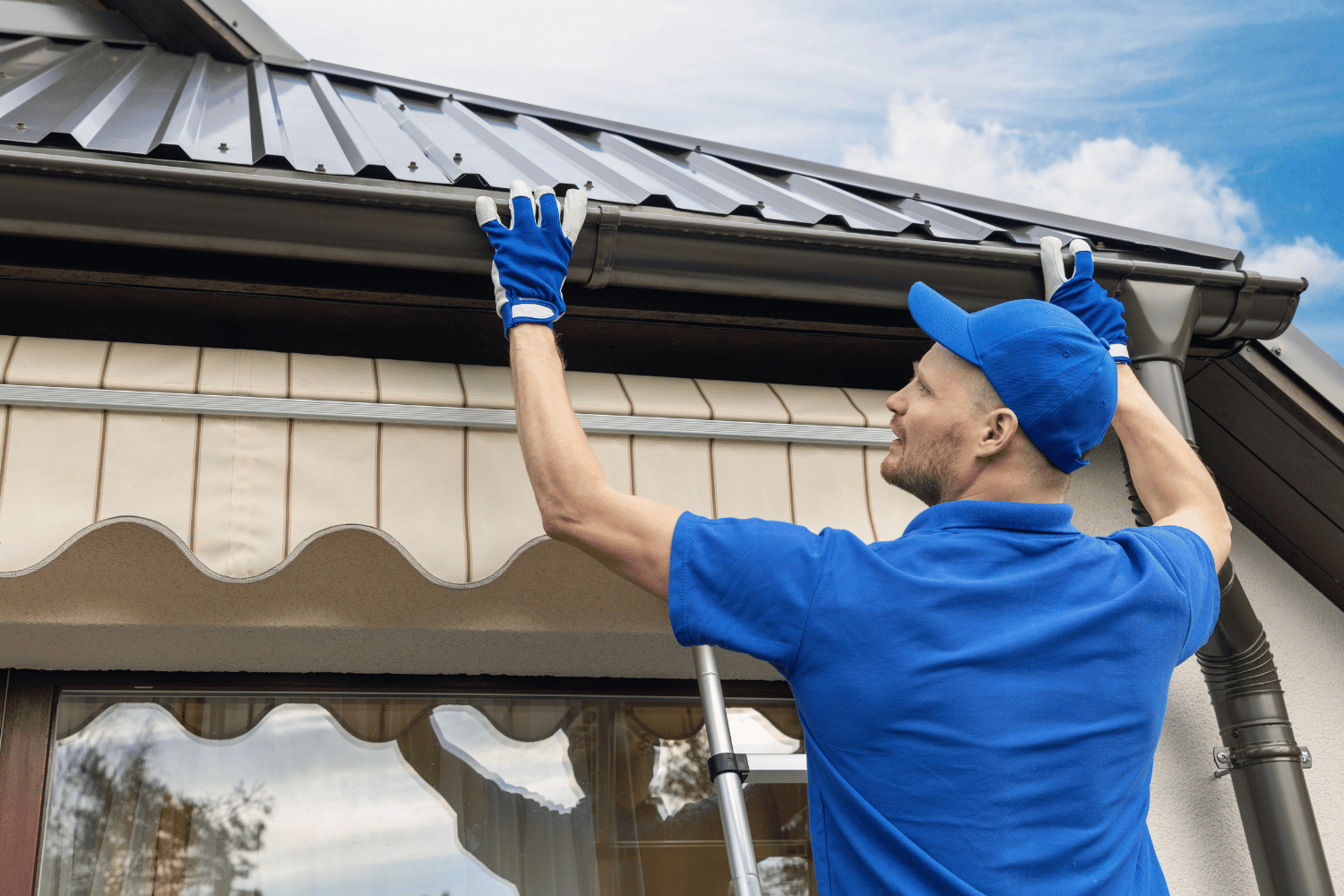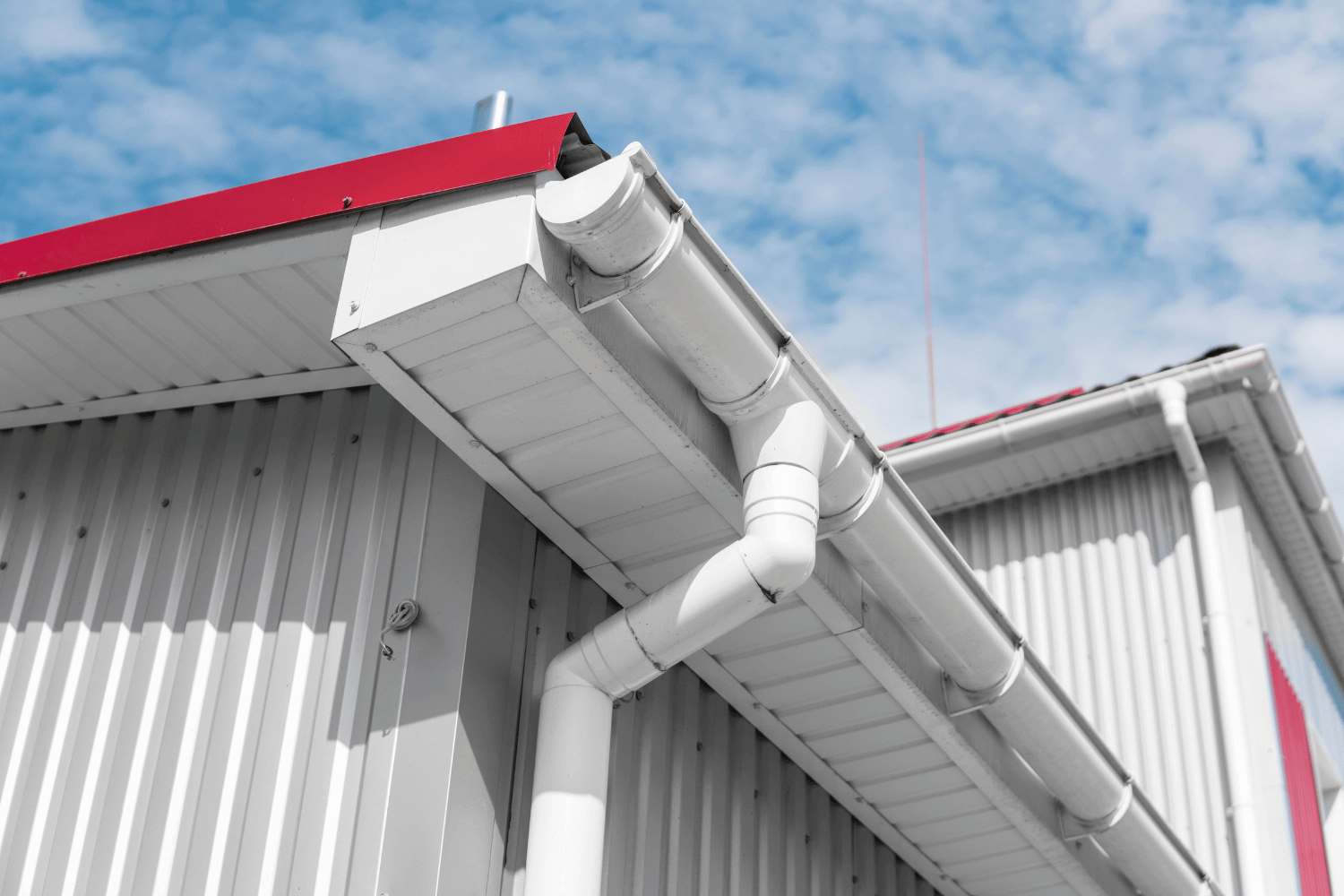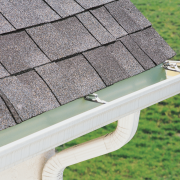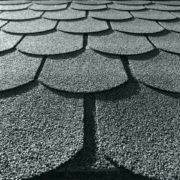Best Tips for Rain Gutter Guard Installation
Wondering how to handle rain gutter guard installation? This guide will provide you with clear steps and tips to install them effectively, ensuring your gutters stay clean and functional.
Key Takeaways
-
Rain gutter guards reduce the frequency of cleaning and prevent clogs, protecting the roof and foundation from potential damage.
-
Choosing the right type of gutter guard depends on specific needs, such as environmental conditions and gutter style, and should be paired with accurate measurements for effective installation.
-
Regular inspections and maintenance are crucial, even with gutter guards installed, to ensure functionality and address any potential issues promptly.
Understanding Rain Gutter Guards

Rain gutter guards prevent leaves and debris from clogging your gutters while allowing rainwater to flow freely. They help maintain the health of your gutter system and home structure by preventing clogs, protecting the roof, and reducing gutter cleaning frequency. Additionally, installing gutter guard systems can enhance the effectiveness of your gutter guards.
While they don’t completely eliminate the need for maintenance, they significantly reduce it, making it easier and less frequent.
Types of Gutter Guards
There are several types of gutter guards and gutter screens, each with its own set of features and benefits. Mesh screens, one of the most common types, are made from metal or plastic with perforated holes that allow rainwater to pass through while blocking larger debris like leaves and twigs.
Brush gutter guards resemble giant pipe cleaners and use stiff bristles to intercept debris, allowing water to flow through. Foam gutter guards fit directly into the gutter and block debris while permitting water flow, although they require more frequent cleaning.
Another effective type is the micro-mesh gutter guard, which offers superior protection by fitting under roof shingles and attaching to the gutter’s edge, thus providing fine filtration against small debris. Reverse-curve gutter guards use the principle of surface tension to direct water into the gutter while debris slides off the edge.
Each type has its own pros and cons, and choosing the right one depends on your specific needs and conditions.
Benefits of Installing Gutter Guards
Before:
Gutter guard installation offers numerous benefits that go beyond just reducing the frequency of cleaning. They prevent debris buildup in gutters, which can lead to clogs and overflow, potentially causing severe structural damage to your home’s roof and foundation. By keeping the gutters clean, these guards also help in preventing pest infestations, as clogged gutters can become a breeding ground for insects and rodents.
After:
Gutter guard installation offers numerous benefits, including:
-
Reducing the frequency of cleaning
-
Preventing debris buildup in gutters, which can lead to clogs and overflow
-
Avoiding severe structural damage to your home’s roof and foundation
-
Helping to prevent pest infestations, as clogged gutters can become a breeding ground for insects and rodents
Moreover, gutter guards protect your home by ensuring rainwater flows efficiently away from the structure, thereby preventing water damage and maintaining the integrity of the roof and foundation. Installing gutter guards, especially low-maintenance options like micro-mesh guards, can save homeowners time and effort in long-term maintenance.
Preparing for Gutter Guard Installation

Preparation is key to a successful gutter guard installation. Start by accurately measuring the lengths and widths of your gutters to ensure a proper fit. Choose the most suitable gutter guard option based on factors such as your roof type, surrounding environment, and budget.
Finally, gather all necessary tools and materials, which may include a ladder, measuring tape, and safety equipment. Doing proper prep work is essential. It can help you save both time and money during the installation process.
Measuring Your Gutters
Accurate measurements are crucial to ensure that your gutter guards fit properly and prevent debris from infiltrating the system. Gutters are typically measured in linear feet, and knowing the style of gutters is important for compatibility. Incorrect measurements can lead to gaps or openings that allow leaves and debris to enter, and choosing the wrong gutter size can cause water overflow during heavy rain, leading to damage.
Ensure gutters are properly pitched before installation to allow for optimal water flow.
Choosing the Right Gutter Guards
When selecting gutter guards, consider factors such as location, price, and the type of debris that typically collects in your gutters. Choosing the wrong type of gutter guard can lead to ineffective performance and increased maintenance needs.
In heavily forested areas, micro-mesh gutter guards are recommended due to their ability to handle large debris effectively. Properly selected gutter guards can significantly reduce the frequency of gutter cleaning, saving you time and money in the long run.
Gathering Tools and Materials
Essential tools for gutter guard installation generally include a ladder, tape measure, hammer, screwdriver, and circular saw. Homeowners can keep tools organized and accessible by putting them in a bucket and hanging it on an S-hook on the ladder to ensure safety during installation.
Tools like tin snips, circular saws, and utility knives are useful for trimming gutter guards to the correct size.
Step-by-Step Gutter Guard Installation

The installation process of gutter guards can vary depending on the type of product you choose. However, a general order of steps can be followed for most installations.
Start by cleaning your gutters thoroughly, then measure and trim the gutter guards to fit, and finally secure them in place using screws, clips, or other fasteners. Complete the installation on a dry and warm day for the best results.
Cleaning the Gutters
Thoroughly cleaning your gutters before installing guards is crucial to prevent debris from interfering with their effectiveness. Use a ladder, gloves, a hose with a spray nozzle, a bucket, and an S-hook to assist in the cleaning process. Remove any leaves and debris, and run water through the gutters to check for leaks and ensure proper flow.
This step ensures that water will flow freely and exit the downspout, indicating that the gutters are ready for guard installation.
Trimming and Fitting Gutter Guards
To accurately fit gutter guards, measure the remaining space, mark the measurement, and then cut accordingly. Use tin snips or a utility knife to trim the guards to size effectively. Be sure to account for any obstructions like downspouts to ensure a proper fit.
Proper trimming is essential to avoid gaps or overlaps that could lead to debris entering the gutter system.
Securing the Gutter Guards
Securely attaching gutter guards helps prevent them from shifting or detaching during heavy rain or strong winds. Common methods for fastening gutter guards include using screws, clips, or other fasteners designed for the specific type of guard.
Ensuring that gutter guards are securely fastened is crucial for maintaining their effectiveness against debris and weather-related challenges. If you want to protect your home, consider to purchase gutter guards and install gutter guards.
Safety Tips for Gutter Guard Installation

Safety should always be a top priority when installing gutter guards. Minimize ladder time by completing as much ground work as possible first and using a partner for stability and handing materials. Wearing safety harnesses can provide extra protection when working at heights.
Long-sleeved clothing can help protect your skin from debris and sharp edges during installation.
Ladder Safety
A stable ladder is crucial for safe gutter guard installation; always check its condition before use. Ensure the ladder is placed on a flat, stable surface to prevent tipping. Installing gutter guards can be physically demanding and may pose safety risks for inexperienced individuals.
Always practice ladder safety to avoid accidents.
Protective Gear
Wearing protective gear is essential for safety during gutter guard installation. Recommended gear includes safety glasses, gloves, and a hard hat. It’s also advisable to wear a long-sleeved shirt and work pants to protect your skin from debris and sharp edges.
Proper footwear ensures stability when working on ladders or roofs.
DIY vs. Professional Gutter Guard Installation
Deciding between DIY and professional gutter guard installation depends on various factors, including your comfort with heights and the complexity of your gutter system. DIY installation can save you money, but it requires the right tools and skills.
On the other hand, professional installation offers the convenience of having experts do the job, often with better warranties and reliability.
Pros and Cons of DIY Installation
DIY installation of gutter guards can be cost-effective and rewarding if you have the right tools and skills. However, it can be challenging for those uncomfortable with ladders and might lead to roof damage if installed improperly.
Safety equipment and following ladder safety practices are essential to ensure a safe DIY installation.
Benefits of Professional Installation
Professional gutter guard installation ensures that the system is correctly installed, minimizing the risk of water issues. Professionals often include a thorough assessment of the gutters and any necessary repairs. They are usually licensed and insured, providing added trust and reliability in their workmanship.
Professionally installed gutter guards often come with better warranties than DIY options.
Common Mistakes to Avoid
Avoiding common mistakes during gutter guard installation can save you time and money. Failing to match the gutter’s pitch can cause water to pool instead of draining, potentially damaging your home’s foundation.
Always read and follow the instructions carefully to ensure a successful installation process.
Incorrect Measurements
Accurate measurements are critical to ensure that gutter guards fit properly, preventing debris from accumulating and ensuring effective water flow. Common measurement errors include miscalculating the length of the gutters and not accounting for angles or corners.
Using a measuring tape, level, and straightedge can enhance the accuracy of your measurements. Ensuring accurate measurements will save time and resources by reducing the likelihood of poor fitting and the need for rework.
Inadequate Cleaning
Thoroughly cleaning gutters before installing guards is essential to prevent debris buildup and ensure proper airflow. Inadequate cleaning can lead to blockages that cause water overflow, leading to potential damage to the home’s foundation and landscaping.
Addressing existing gutter problems prior to installation helps guarantee the effectiveness of the gutter guards and prolongs their lifespan.
Maintenance Tips for Gutter Guards

Regular cleaning and inspection of gutter guards are essential to ensure they effectively prevent clogs. Even with gutter guards in place, gutters should be cleaned at least twice per year to prevent potential overflow.
Gutter guards help prevent mold and mildew by minimizing the accumulation of debris that can trap moisture, and they also deter pests like rodents and insects from nesting in gutters.
Regular Inspections
Inspections of gutter guards should be conducted at least biannually, especially after heavy rain or snow. During inspections, look for small leaks or cracks that may require immediate attention. Gutter guards aren’t maintenance-free; they require periodic cleaning of the surface to remove debris.
Regular inspections help maintain their effectiveness and prevent damage.
Cleaning and Repairs
Using a pressure washer to clean gutter guards should be done with caution, ensuring the pressure does not exceed 1800 psi to avoid damage. Cleaning the top of gutter guards can often be done with specialized tools designed for gutter maintenance.
The type of gutter guard influences how often it needs to be cleaned; basic guards may require cleaning one to two times a year, while premium options can last up to two years.
Summary
In summary, installing gutter guards is a valuable investment that protects your home from water damage and reduces maintenance efforts. By understanding the types of gutter guards, preparing adequately, following safety tips, and avoiding common mistakes, you can ensure a successful installation. Regular maintenance and inspections will keep your gutter system functioning efficiently for years to come. Take the leap and install gutter guards to safeguard your home.
Frequently Asked Questions
What are the main types of gutter guards available?
The main types of gutter guards are mesh screens, brush guards, foam inserts, and reverse-curve guards, each offering distinct advantages based on your needs and surrounding conditions. Selecting the right type can significantly reduce maintenance and improve drainage efficiency.
How often should I clean my gutters if I have gutter guards installed?
It’s important to clean your gutters at least twice a year, even with gutter guards, to maintain their effectiveness and prevent overflow. Regular maintenance is key to protecting your home from water damage.
Can I install gutter guards myself, or should I hire a professional?
You can install gutter guards yourself to save money, but hiring a professional is recommended for proper installation, especially for complex systems or if you are uneasy with heights.
What are the benefits of installing gutter guards?
Installing gutter guards minimizes the need for frequent cleaning, protects your home from water damage, and reduces the risk of pest infestations. Ultimately, they contribute to a more efficient and low-maintenance gutter system.
What should I do if my gutter guards need repairs?
If your gutter guards need repairs, conduct regular inspections and promptly address any damage using specialized tools for cleaning. This will help maintain their effectiveness and prevent further issues.








